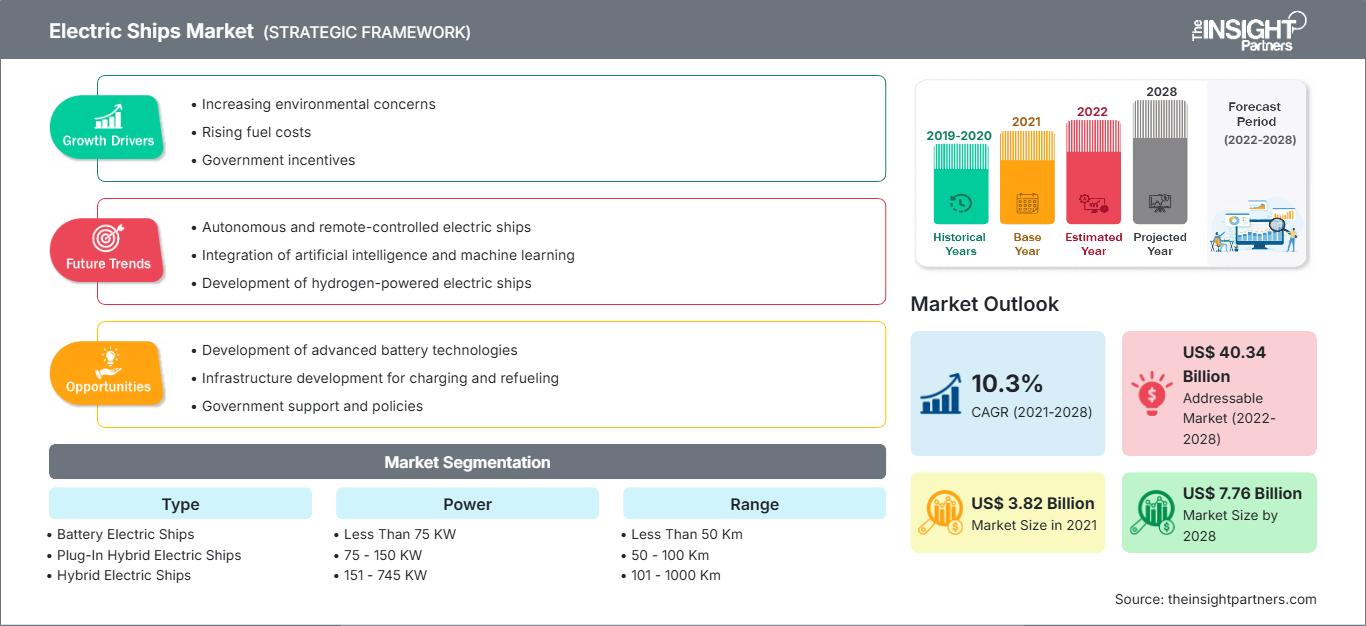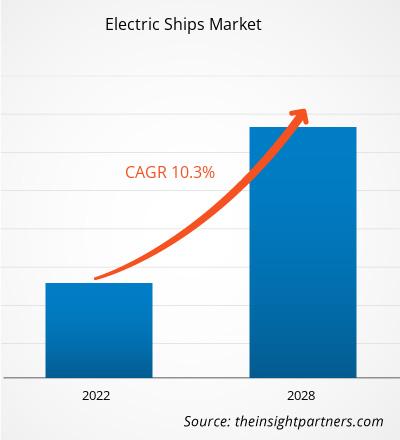El mercado de barcos eléctricos se valoró en US$ 3.820 millones en 2021 y se estima que crecerá a una CAGR del 10,3% entre 2021 y 2028.
Un barco eléctrico es cualquier barco o embarcación cuya tecnología de propulsión principal es un sistema de accionamiento eléctrico. Puede ser un barco o embarcación eléctrica de batería completa, eléctrica de pila de combustible de hidrógeno, eléctrica híbrida, desde remolcadores, transbordadores, buques de carga y barcazas hasta turísticos, barcos de pesca de arrastre, yates de crucero y vehículos submarinos no tripulados (UUV). Los barcos eléctricos se impulsan eléctricamente, a diferencia de los barcos convencionales con motor diésel. Estos barcos utilizan un dispositivo de almacenamiento de batería como fuente de energía para impulsar los motores eléctricos. Se pueden utilizar numerosos tipos de baterías en un barco eléctrico, incluyendo baterías de iones de litio, baterías de plomo-ácido y pilas de combustible. Los barcos eléctricos son principalmente transportadores y pequeños barcos de pasajeros en vías navegables interiores que navegan completamente con electricidad. Recorren distancias cortas con ~80 km en una sola carga. Además, los barcos de energía solar también se utilizan en barcos ligeros que requieren baja potencia de salida. Sin embargo, las necesidades de energía de los buques de carga no pueden ser satisfechas por un sistema completamente eléctrico debido a su gran peso; por lo tanto, los buques de carga utilizan un sistema híbrido diésel-eléctrico.
Personalice este informe según sus necesidades
Obtendrá personalización en cualquier informe, sin cargo, incluidas partes de este informe o análisis a nivel de país, paquete de datos de Excel, así como también grandes ofertas y descuentos para empresas emergentes y universidades.
Mercado de barcos eléctricos: Perspectivas estratégicas

-
Obtenga las principales tendencias clave del mercado de este informe.Esta muestra GRATUITA incluye análisis de datos, desde tendencias del mercado hasta estimaciones y pronósticos.
Impacto de la pandemia de COVID-19 en el mercado de barcos eléctricos
La pandemia de COVID-19 afectó negativamente al mercado de los barcos eléctricos. Esta pandemia tuvo un impacto global sin precedentes en la movilidad humana. En el océano, las actividades marítimas se ven afectadas debido a las severas restricciones a la movilidad humana y los cambios en el consumo de bienes. Algunos países han cerrado su industria de cruceros debido a la pandemia de COVID-19. Sin embargo, algunas líneas de cruceros están intentando reanudar sus actividades durante la pandemia. Las actividades humanas en el océano se han visto radicalmente alteradas por la pandemia de COVID-19, con informes de restricciones portuarias y cambios en los patrones de consumo que afectan a múltiples sectores marítimos, la pesca, los transportadores de pasajeros y los cruceros. No obstante, en algunas regiones, el transporte marítimo de mercancías se declaró esencial durante el confinamiento, lo que creó una oportunidad lucrativa para el mercado de los barcos eléctricos.
Perspectivas del mercado de barcos eléctricos
Aumento en la adopción de sistemas de propulsión híbridas y eléctricas para modernizar buques
La modernización de buques está ganando interés y atrae a armadores y constructores navales para prolongar la vida útil de sus buques existentes. Este proceso ofrece la oportunidad de reducir el consumo de combustible y mantenerse al día con las últimas soluciones ecológicas como un procedimiento rentable. La modernización se está convirtiendo en una práctica común en la industria marítima. Los constructores navales están avanzando hacia la automatización, integrando buques de nueva construcción y modernizando los buques existentes con sistemas de propulsión híbridos y eléctricos. Este sistema es una opción conveniente para modernizar buques obsoletos con un enorme potencial de modernización, incluyendo transbordadores, portacontenedores, cruceros, remolcadores y buques de carga general. Los constructores navales optan por modernizar sus buques con un sistema de propulsión híbrido-eléctrico o un sistema de propulsión totalmente eléctrico, ya que es una opción relativamente más económica que comprar un buque nuevo. Además, varios constructores navales europeos están modernizando activamente su flota actual con sistemas de propulsión híbridos y eléctricos. Por ejemplo, según el artículo publicado por Riviera Maritime Media Ltd, en marzo de 2020, los armadores de buques de suministro de alta mar (OSV) invirtieron en la modernización de flotas diésel-eléctricas/GNL con propulsión híbrida por batería, una iniciativa que está dando buenos resultados tanto para el fletador como para el armador, así como para la protección del medio ambiente en Noruega. Estos factores han propiciado la adopción de sistemas de propulsión híbridos y eléctricos para la modernización de buques.
Perspectivas del mercado basadas en tipos
Según el tipo, el mercado de barcos eléctricos se segmenta en barcos eléctricos de batería, barcos eléctricos híbridos enchufables y barcos eléctricos híbridos. El segmento de barcos eléctricos híbridos lideró el mercado en 2020. La fiabilidad que ofrecen los barcos eléctricos híbridos respalda su demanda gracias al uso de sistemas de propulsión complementarios y a una mayor velocidad, lo que puede reducir el riesgo de fallos y cubrir mayores distancias en menos tiempo. Además, la propulsión de los buques eléctricos híbridos puede ser eléctrica (a través de diésel-eléctrico o impulsado por batería) o mecánica (accionamiento directo por diésel). Asimismo, los armadores o las empresas navieras y logísticas de todo el mundo prefieren los barcos eléctricos híbridos, ya que permiten un menor consumo de combustible y ayudan a reducir los costes operativos. El uso de propulsión diésel-eléctrica a baja potencia y propulsión directa por diésel para la navegación fluvial en aguas interiores con diferentes velocidades permite reducir los costes operativos de los barcos eléctricos. Esta es una forma más inteligente de utilizar la energía disponible y ahorrar en costes de combustible mediante el uso de la propulsión eléctrica híbrida.
Los actores del mercado de barcos eléctricos adoptan estrategias como fusiones, adquisiciones e iniciativas de mercado para mantener su posición en el mercado. A continuación, se enumeran algunos avances de los actores clave.
- En noviembre de 2021, BAE Systems lanzó un sistema de energía y propulsión de última generación para ayudar a los operadores marítimos a alcanzar cero emisiones. Ofrece una solución flexible que mejora la eficiencia eléctrica y la autonomía de las embarcaciones, aumenta la potencia de propulsión y simplifica la instalación.
- En septiembre de 2020, Kolumbus (empresa de movilidad) y Fjellstrand (constructor naval) firmaron un contrato para la entrega del primer ferry rápido totalmente eléctrico del mundo. Este proyecto recibió financiación del programa de investigación e innovación Horizonte 2020 de la Unión Europea.
Según el tipo, el mercado de barcos eléctricos se segmenta en barcos eléctricos de batería, barcos eléctricos híbridos enchufables y barcos eléctricos híbridos. Según la potencia, el mercado de barcos eléctricos se segmenta en menos de 75 kW, 75-150 kW, 151-745 kW, 746-7560 kW y más de 7560 kW. Según el alcance, el mercado de barcos eléctricos se clasifica en menos de 50 km, 50-100 km, 101-1000 km y más de 1000 km. Según el tipo de barco, el mercado de barcos eléctricos se segmenta en cruceros, transbordadores, petroleros, graneleros, buques pesqueros, destructores, portaaviones y otros. Por geografía, el mercado de barcos eléctricos se segmenta en cinco regiones principales: América del Norte, Europa, Asia Pacífico (APAC), Oriente Medio y África (MEA) y América del Sur (SAM).
Perspectivas regionales del mercado de barcos eléctricos
Los analistas de The Insight Partners han explicado detalladamente las tendencias regionales y los factores que influyen en el mercado de buques eléctricos durante el período de pronóstico. Esta sección también analiza los segmentos y la geografía del mercado de buques eléctricos en Norteamérica, Europa, Asia Pacífico, Oriente Medio y África, y Sudamérica y Centroamérica.
Alcance del informe de mercado de barcos eléctricos
| Atributo del informe | Detalles |
|---|---|
| Tamaño del mercado en 2021 | US$ 3.82 mil millones |
| Tamaño del mercado en 2028 | 7.760 millones de dólares estadounidenses |
| CAGR global (2021-2028) | 10,3% |
| Datos históricos | 2019-2020 |
| Período de pronóstico | 2022-2028 |
| Segmentos cubiertos |
Por tipo
|
| Regiones y países cubiertos |
América del norte
|
| Líderes del mercado y perfiles de empresas clave |
|
Densidad de actores del mercado de barcos eléctricos: comprensión de su impacto en la dinámica empresarial
El mercado de barcos eléctricos está creciendo rápidamente, impulsado por la creciente demanda del usuario final debido a factores como la evolución de las preferencias de los consumidores, los avances tecnológicos y un mayor conocimiento de los beneficios del producto. A medida que aumenta la demanda, las empresas amplían su oferta, innovan para satisfacer las necesidades de los consumidores y aprovechan las tendencias emergentes, lo que impulsa aún más el crecimiento del mercado.

- Obtenga una descripción general de los principales actores clave del mercado de barcos eléctricos.
Perfiles de empresas
- BAE Systems
- Compañía de barcos eléctricos Duffy
- Fjellstrand AS
- X Shore
- Barco eléctrico General Dynamic
- Hurtigruten
- Soluciones energéticas MAN
- PortLiner
- Siemens Energía
- VARD AS
- Análisis histórico (2 años), año base, pronóstico (7 años) con CAGR
- Análisis PEST y FODA
- Tamaño del mercado, valor/volumen: global, regional y nacional
- Industria y panorama competitivo
- Conjunto de datos de Excel
Informes recientes
Testimonios
Razón para comprar
- Toma de decisiones informada
- Comprensión de la dinámica del mercado
- Análisis competitivo
- Información sobre clientes
- Pronósticos del mercado
- Mitigación de riesgos
- Planificación estratégica
- Justificación de la inversión
- Identificación de mercados emergentes
- Mejora de las estrategias de marketing
- Impulso de la eficiencia operativa
- Alineación con las tendencias regulatorias






















 Obtenga una muestra gratuita para - Mercado de barcos eléctricos
Obtenga una muestra gratuita para - Mercado de barcos eléctricos